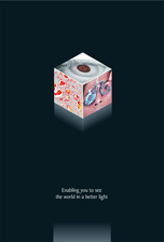ABOUT EYE - TYPES OF CATARCT
CATARACT---- Opacity of natural crystalline lens in the eye , a clinically significant cataract is one that affects vision
TYPES OF CATARACT
A) AGE RELATED CATARACTS ?
- Anterior Subcapsular Cataract- Lies directly under the lens capsule and is associated with fibrous mataplasia of the anterior epithelium of the lens
- Posterior Subcapsular Cataract-Lies just in front of the posterior capsule and is associated with posterior migration of the epithelial cells of the lens .
- Nuclear Cataract- Start as an exaggeration of the normal aging change involving the lens nucleus
- Cortical Cataract- involvesthe anterior, posterior and equatorial cortex. The opacities starts as vacuoles and clefts between the lens
- Hypermature Cataract- Leakage of water has resulted from lens which leads to shrinkage of cataract and wrinkling of anterior capsule
- Incipient Cataract- wedge shaped spokes of opacity with clear areasbetween them appear in the peripheryof the lens , they lie in the cortex , some in front and some behind the nucleus
- Cuneiform Cataract- at the ageof around 48 yrs and is due to maximum accommodative stress just beforethe onset of presbyopia. Deeper layers of cortex become cloudy and eventually uniformly white or opaque
B) PRE SENILE CATARACTS?
- Diabetes- May result in osmotic overhydration of the lens and development of bilateral white punctuate or snowflakes posterior or anterior opacifies
- Myotonic Dystrophy- Stellate posterior subcapsular cataract
- Atopic Dermatitis- shield cataract, post subcapsular cataract
- Neurofibromatosis type -2- post subcapsular cataract, posterior cortical cataract
C) TRAUMATIC CATARACT (UNILATERAL)
Causes for traumatic cataract are- Direct penetrating injury
- Concussion---vossius ring flower shaped
- Electric shock and lighting
- Ionizing irradiation to ocular tumours
D) TOXIC CATARACT
- Steroids- post subcapsular cataract most common
- Chlorpromazine- yellowish brown granules on the anterior lens capsule
- Miotics- tiny anterior subcapsular vacuoles
- Gold- innocuous anterior capsular lens deposits
E) MORPHOLOGICAL TYPES( CONGINIETAL)
- Nuclear cataract- opacityof the central zone between anterior and posterior Y sutures associated with microophtalmus and microcornea
- Lamellar cataract- Opacity sandwhiched between clear nucleus and cortex
- Sutural Cataract- follows the anterior or posterior Y suture. It may occur in isolation or in association with other opacities
- Coronary Cataract- (supranuclear)- round opacity in deep cortex which surround the nucleus like a crown usually sporadic or herediatary
- Polar cataract- aneterior polar cataract, posterior polar cataract
- Blue dot cataract- small opaque spots are multiple and scattered all over the lens and apperaring as tiny blue spots by oblique illumination
- Zonular cataract- Area around embryonic nucleus becomes opacified , opacity is sharply demarketed and the area of lens within and around the opaque zone is clear riders may run towards the equator
F) COMPLICATED CATARACT
- Chronic anterior uveitis
- Acute congestive angle closure glaucoma- small grey ahite , anterior subcapsular cataract
- High Myopia- posterior lens opacities
- Hereditary fundus dystrophy- (retinitis Pigmentosa)—posterior subcapsular cataract
G) RADIANT OR OTHER ENERGY
- Heat(infra red) cataract –(glass workers or iron workers)- small disc of opacity in the posterior cortex of the lens
- Irradiation cataract- in the cortex near the posterior pole heat cataract is seen (1-2 yrs after radiation)
( workers in atomic bombs released over Japan in 2 nd world war)
SYMPTOMS OF AQUIRED CATARACT
- Seeing spots before the eye (stationary)
- Uniocular polyopia (doubling or trebling of the objects seen with the eye )
- Coloured haloes
- Reduced central visual acuity – blurred, hazy vision
- Peripheral opacities- constricted pupil better vision
- Central opacities- dilated pupils better vision
- Nuclear sclerosis leads to development of progressive myopia
- Opacification proceeds , vision steadly diminishes until only perception of light remains
EVALUATION OF CATARACT
- By visual acuity- depending on vision recordde the grade of cataract can be identified( from grade I to Grade V
- Depending on vision the cataract can be identified as immature, advance cataract, mature cataract
- Colour- depending on the colour of opacity it is identified the type of cataract
- By symptoms- cataract can also be identified and categorised depending on the symptoms
PROCEDURE OF CATARACT SURGEY
The cataract surgery is generally done in either of two ways- Large Incision Extracapsular cataract
- Phacoemulcification
COMPLICATIONS
- If consent not taken
- Anaesthetic problems
- Capsular rupture without vitreuos loss
- Capsular rupture with vitreous loss
- Suprachoroidal haemorraghe
- Corneal tear
- Iris prolapse
- Inflammation of cornea- straite keratitis
- Hypema
- Iritis
- Pus formation
- efractive error----if wrongly IOL is implanted
Eye Bank
Gokhale Eye Hospital and Eye Bank Tel : 022-24221820Parel eye bank: 022-24162929
MUMBAI HOTLINE FOR EYE DONATION IS 1919.
News & Events
Tips To Protect Young EyesParents should take extra care in selecting toys for young children and supervising their play during the holidays, according to a leading eye surgeon.
Seasonal Disease
Allergic conjunctivitis or spring catarrh is a very common seasonal disorder in children between 5 - 15 years of age. The disorder can only be suppressed. Cure cannot be offered.Download Brochure








